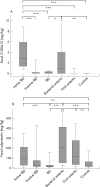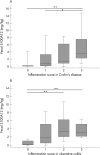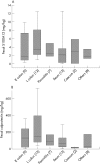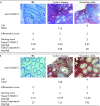Faecal S100A12 as a non-invasive marker distinguishing inflammatory bowel disease from irritable bowel syndrome
- PMID: 17675327
- PMCID: PMC2095695
- DOI: 10.1136/gut.2006.113431
Faecal S100A12 as a non-invasive marker distinguishing inflammatory bowel disease from irritable bowel syndrome
Abstract
Objective: S100A12 is a pro-inflammatory protein that is secreted by granulocytes. S100A12 serum levels increase during inflammatory bowel disease (IBD). We performed the first study analysing faecal S100A12 in adults with signs of intestinal inflammation.
Methods: Faecal S100A12 was determined by ELISA in faecal specimens of 171 consecutive patients and 24 healthy controls. Patients either suffered from infectious gastroenteritis confirmed by stool analysis (65 bacterial, 23 viral) or underwent endoscopic and histological investigation (32 with Crohn's disease, 27 with ulcerative colitis, and 24 with irritable bowel syndrome; IBS). Intestinal S100A12 expression was analysed in biopsies obtained from all patients. Faecal calprotectin was used as an additional non-invasive surrogate marker.
Results: Faecal S100A12 was significantly higher in patients with active IBD (2.45 +/- 1.15 mg/kg) compared with healthy controls (0.006 +/- 0.03 mg/kg; p<0.001) or patients with IBS (0.05 +/- 0.11 mg/kg; p<0.001). Faecal S100A12 distinguished active IBD from healthy controls with a sensitivity of 86% and a specificity of 100%. We also found excellent sensitivity of 86% and specificity of 96% for distinguishing IBD from IBS. Faecal S100A12 was also elevated in bacterial enteritis but not in viral gastroenteritis. Faecal S100A12 correlated better with intestinal inflammation than faecal calprotectin or other biomarkers.
Conclusions: Faecal S100A12 is a novel non-invasive marker distinguishing IBD from IBS or healthy individuals with a high sensitivity and specificity. Furthermore, S100A12 reflects inflammatory activity of chronic IBD. As a marker for neutrophil activation, faecal S100A12 may significantly improve our arsenal of non-invasive biomarkers of intestinal inflammation.
Conflict of interest statement
Competing interests: None.
Comment in
-
Magic markers?Inflamm Bowel Dis. 2009 Feb;15(2):313-4. doi: 10.1002/ibd.20626. Inflamm Bowel Dis. 2009. PMID: 18798575 No abstract available.
References
-
- Hanauer S B. Inflammatory bowel disease: epidemiology, pathogenesis, and therapeutic opportunities. Inflamm Bowel Dis. 2006;12(Suppl 1)S3–S9. - PubMed
-
- Niederau C, Backmerhoff F, Schumacher B. Inflammatory mediators and acute phase proteins in patients with Crohn's disease and ulcerative colitis. Hepatogastroenterology 19974490–107. - PubMed
Publication types
MeSH terms
Substances
LinkOut - more resources
Full Text Sources
Other Literature Sources
Medical
Research Materials
Miscellaneous





